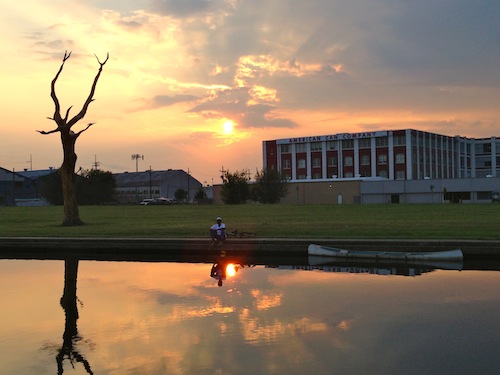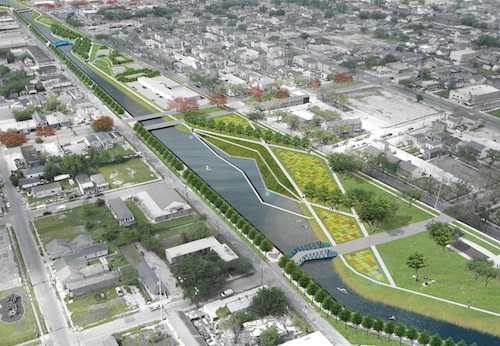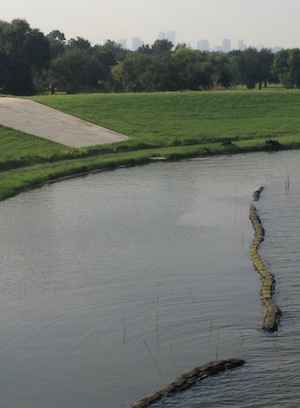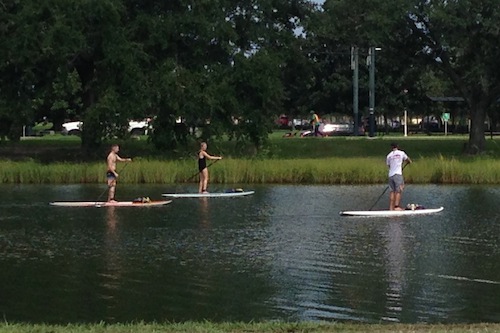Dredging at the mouth of Bayou St. John is nearly complete, with the sediment being used to anchor wetlands that will foster wildlife. The dam that was compared to a coronary blockage has been removed, allowing water to pass more freely. Proponents say the project shows how the city can live with the water around us, rather than fight it.

The waterfall dam beneath Robert E. Lee Boulevard was ripped out in January. A few hundred yards away, dredging at the lakefront mouth of Bayou St. John should be completed next month, with much of the muck retained to create wetlands just north of the gates that now seal the bayou — and the heart of New Orleans — against storm surge.
The task immediately at hand is to reconnect today’s stagnant Bayou St. John to Lake Pontchartrain, restore something like its natural flow, and relish the recovery of wildlife and the expansion of recreational uses for the bayou. But that’s only a beginning.
Work on the bayou could be a gateway to an ambitious blueprint, the Urban Water Plan, that envisions underground canals below water-permeable streets, the removal of canal floodwalls and the greening of rooftops to collect rainwater.
The whole plan is driven by a single idea: that we must learn to live with the water all around New Orleans, rather than fight doggedly to keep it out of the city. We must accept it as a friend to keep it from becoming an enemy.
It’s a reversal from the approach that has shaped the bayou over the past 50 years. The old waterfall dam, for instance, was built in 1962 to prevent flooding from the lake.
That dam was like a “99 percent coronary blockage” that starved the bayou of fresh water and aquatic life, said Mark Schexnayder, deputy assistant secretary of the Louisiana Department of Wildlife and Fisheries.
Likewise, some of the approximately 8,000 cubic feet of sediment now being dredged to deepen the channel mouth was dumped there when the Orleans Levee District and the U.S. Army Corps of Engineers thought it best to practically plug the bayou by building a grade-level roadway.
The Urban Water Plan report describes how the thinking has changed:
The Urban Water Plan proposes the restoration of the city’s canals to prominence as historic water corridors, each of which provides the city’s residents with access to new water-based amenities in the form of blueways, greenways, water plazas, and parklands.
“The bayou is our best case in point as a feature that helps to hold water and control interior flooding, and at the same time is an economic amenity,” said Michael Hecht, the chief executive officer of Greater New Orleans Inc., the nonprofit economic development group that is promoting the Urban Water Plan.
“The enduring quality of Bayou St. John,” he said, “is a testament to the wisdom of having open water and circulation,” a concept central to the plan.
“It’s a prime example of what we can do when we manage water right,” Schexnayder said.
A new approach to waterways in the city

The Urban Water Plan proposes seven demonstration projects stretching from Jefferson to St. Bernard parishes that aim to reduce flooding and subsidence, and enhance the local economy and quality of life.
Among them is the “Lafitte Blueway,” a canal running down the center of the Lafitte Corridor, the three-mile stretch of green space connecting City Park to Armstrong Park. It would be an important beneficiary of a healthier bayou.
Bayou St. John is the linchpin of those projects, according to David Waggonner, a local architect and designer who has worked with the Dutch on the Urban Water Plan.
“It’s the key to the New Orleans area because it’s the source of water to the other canals,” he said. His firm, Waggonner & Ball, created the Urban Water Plan in collaboration with GNO Inc.
[module align=”right” width=”half” type=”pull-quote”]“The enduring quality of Bayou St. John is a testament to the wisdom of having open water and circulation.” —Michael Hecht, CEO of GNO Inc.[/module]Perhaps the most startling of the plan’s proposals is removal of the floodwalls that top the levees along many miles of outfall canals. Their failure during Katrina contributed to the devastation.
Toppling them, now that the canal mouths have been gated against storm surge, will have an equally dramatic but positive impact, according to the plan:
With floodwalls removed, the primary canals are significant public assets, with parks, trails, docks, and waterfront development in place of the ditches and barren concrete structures that carry storm water today.
Restoring a more natural flow to the city’s interior waterways will also alleviate a major threat to the city: subsidence, which results when the water table drops in a city built on silt rather than bedrock.
The report notes that “the region’s current water-management paradigm, captured by the phrase ‘pave, pipe and pump,’ removes water from the landscape and throws off the water and soils out of balance.”
During dry periods, Bayou St. John will keep the city’s waterways filled and thus mitigate subsidence, Waggonner said.
Efforts to restore the bayou’s natural flow from the lake will proceed cautiously to make sure engineers have not overestimated the friendliness of the lake. It currently feeds the bayou through small sluice gates, controlled by valves that are opened a few times a year and are covered with a mesh that prevents larger fish from entering. The plan is to see whether those gates can be opened more often, allowing water, fish and crabs to move between the lake and the bayou.
The much larger gates at the mouth of the bayou, a storm-protection feature, have remained closed much of the time since their installation in 1992. These, too, are being readied for more frequent openings.
Manmade wetlands to foster aquatic life in bayou
The ongoing effort to restore the health of the bayou includes a complex but increasingly communal partnership between individuals, research institutes, public entities, and private groups and businesses.
[module align=”right” width=”half” type=”pull-quote”]“One of the most important lessons we have learned since Katrina and the failure of the federal levee system is it is us – the people – who have to make things happen.” —Councilwoman Susan Guidry[/module]“It’s really been a community effort,” said Councilwoman Susan Guidry. She was president of the Parkview Neighborhood Association, a part of the Bayou St. John Conservation Alliance, in 2008 when the alliance of 19 businesses, associations, schools, and churches put forth a resolution backing the bayou-lake reconnection project.
“One of the most important lessons we have learned since Katrina and the failure of the federal levee system is it is us – the people – who have to make things happen,” Guidry said.

It was wetland biologist Andy Baker and the Lake Pontchartrain Basin Foundation who saw an opportunity to use the dredge material for a major piece of the restoration effort: building wetlands at the mouth of the bayou.
For more than two months, Baker and a team of volunteers have been creating shoreline walls by stacking black DeltaLok bags filled with 40 pounds of dredged sediment. Plant roots can grow through the permeable bags, allowing vegetation to strengthen and stabilize the banks. For now, the bags are attached to one another with spiked plates.
The eastern and western walls are now complete, and crews have begun to pump dredged sediment behind the walls to create a half-acre mudflat in which native grasses can be planted.
Improved water management will also require keeping tabs on invasive species that displace native plants and animals, said Martin O’Connell, an associate professor of environmental science at the University of New Orleans and the director of UNO’s Nekton Research Laboratory. One of the worst offenders is the Rio Grande cichlid, which likely were dumped from aquariums and found their way into the bayou.
O’Connell said there are already encouraging signs that species of fish that have been absent from the bayou for decades will return. Just a few weeks ago, he spotted a leatherjacket, a fish he’s never seen there.
Meanwhile, he has been monitoring a program to restock the bayou with redfish. He tags them with radio transmitters that are marked with his phone number. (If you catch one, please call him; he wants to know the details.)
In addition to a wildlife habitat that will help kick-start the bayou’s renewed flow and ecosystem, Baker said the wetlands will be aesthetically pleasing. They’ll be a classroom for young people and a resource for people eager to “see nature without leaving the city.”
When shrimp, crabs, fish and other species move in from the lake, they’ll be able to rest, hide, feed and breed in the manmade wetland’s lush marsh grasses.
The project is a “gesture of hope and rebirth,” Baker said, while acknowledging that building wetlands continues to be a trial-and-error process.
Ripple effects of connecting lake, bayou
Lots of testing lies ahead, however, before the bayou and the lake can be more fully reconnected. As the lake pushes more water into the bayou, seven real-time monitoring sites will measure water and oxygen levels, salinity, temperature and conductivity.
A small amount of salinity is a good thing; it acts as a natural herbicide, said Schexnayder, the Wildlife and Fisheries official. But too much will kill cypress trees and other native vegetation.
It’s a delicate balance, but that has always been true of the bayou. The lake pushes water into the bayou. Another kind of movement is created when drains operated by the Sewerage and Water Board, or the intake valves that feed City Park’s bayous and lagoons, are adjusted for water height.
While it’s exciting to imagine throwing the gates open and returning a whole host of species and semi-natural tidal flow to the bayou, all the parties involved acknowledge that flood protection must be prioritized. The gates must be closed during tropical storms because the higher lake water would push into the bayou.
“We can’t have the gate open all of the time,” Schexnayder said — let alone take them out permanently.
Once a commercial corridor, now a recreational one
It’s a different system than Jean-Baptiste Le Moyne de Bienville came upon 300 years ago, Schexnayder added, referring to the Frenchman who identified today’s French Quarter as the place to build what would become New Orleans.
Back then, Bayou St. John — Bayouk Choupic to Choctaw Indians and early European settlers — was a key trade route and an important source of food and other basic necessities for the nascent settlement. It provided easier access to the colony than the perilous 70-mile trek up from the river’s mouth. The bayou lost status as a commercial corridor when the Industrial Canal was opened in 1923.

Though Bayou St. John is not destined to become a channel for maritime commerce again, proponents of the restoration project say the ecological improvements will boost its recreational and economic value – seen already with an upsurge in fishing, crabbing and boaters.
And of course, as Hecht notes, waterfront property is priced at a premium, something he hopes other neighborhoods will discover and envy enough to start tearing down floodwalls no longer needed now that the mouths of the city’s three major outflow canals have been gated.
For centuries, Hecht said, New Orleans treated water as an industrial and commercial asset — when it wasn’t viewed as an outright threat. “We’ve come to realize now that water is an amenity that people pay a premium for in other communities,” he said.
O’Connell envisions tourists hopping off the streetcar at City Park with fishing poles in hand to spend an afternoon pulling out large redfish and speckled trout.
“We can touch it and walk on the banks and fish in it,” Guidry said, describing what makes the bayou unique. “It’s accessible in a way that we are learning waterways should be. It sets it apart from any other waterway.”
Marcella Singleton, a resident along the bayou for the past 15 years, said she wakes up grateful each day for her watery front yard.
“We are so inexorably connected to it and have been for hundreds of years,” she said. “I have had my head washed on St. John’s Eve in a vodou ritual consecrated to Marie Laveau. I have attended both weddings and memorial services on the Blue Bridge and seen offerings both sacred and profane along the bayou’s banks.
“The bayou is the soul of our community. It brings us all together.”

